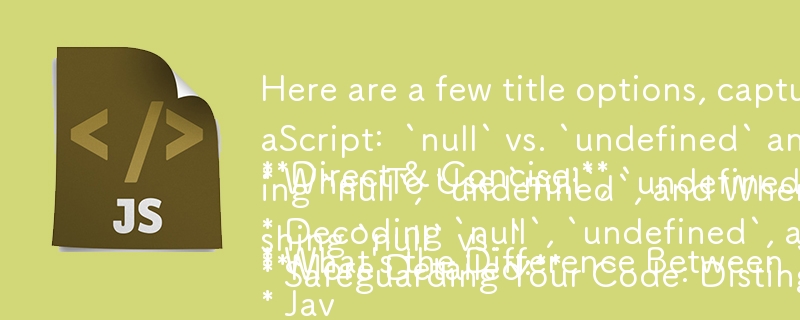Home > Article > Web Front-end > Here are a few title options, capturing the essence of your provided text: **Direct & Concise:** * What\'s the Difference Between `null` and `undefined` in JavaScript? * JavaScript: `null` vs.
Here are a few title options, capturing the essence of your provided text: **Direct & Concise:** * What\'s the Difference Between `null` and `undefined` in JavaScript? * JavaScript: `null` vs.
- Patricia ArquetteOriginal
- 2024-10-26 20:24:30854browse

JavaScript: Distinguishing Null vs. Undefined and Comparing with == vs. ===
Checking for Null and Undefined
Checking for Null:
- Strict comparison: if (a === null)
- Loose comparison: if (a == null) (Caution: Will also return true for undefined)
Checking for Undefined:
- Type comparison: if (typeof a === "undefined")
- Strict comparison: if (a === undefined)
- Loose comparison: if (a == undefined) (Caution: Will also return true for null)
Difference Between Null and Undefined
- Undefined: Default value of uninitialized variables, omitted function arguments, and missing object properties. Denotes an "absence".
- Null: Specifically represents an empty object reference.
Difference Between == and ===
- == (Loose Equality): Performs type coercion to equate values (e.g., "1" == 1 is true).
- === (Strict Equality): Compares both value and type. Returns false if types differ (e.g., "1" === 1 is false).
Note: Strict comparison (===) is recommended for type-safe comparisons and avoiding unexpected results from type coercion.
The above is the detailed content of Here are a few title options, capturing the essence of your provided text: **Direct & Concise:** * What\'s the Difference Between `null` and `undefined` in JavaScript? * JavaScript: `null` vs.. For more information, please follow other related articles on the PHP Chinese website!
Statement:
The content of this article is voluntarily contributed by netizens, and the copyright belongs to the original author. This site does not assume corresponding legal responsibility. If you find any content suspected of plagiarism or infringement, please contact admin@php.cn
Previous article:Why Isn\'t My `addEventListener` Working in Internet Explorer 8?Next article:Why Isn\'t My `addEventListener` Working in Internet Explorer 8?
Related articles
See more- An in-depth analysis of the Bootstrap list group component
- Detailed explanation of JavaScript function currying
- Complete example of JS password generation and strength detection (with demo source code download)
- Angularjs integrates WeChat UI (weui)
- How to quickly switch between Traditional Chinese and Simplified Chinese with JavaScript and the trick for websites to support switching between Simplified and Traditional Chinese_javascript skills